What Amount Of Money Is Given To Children's Cancer
Childhood Cancer Fact Library
A comprehensive, well-documented and trusted source of data for anyone seeking data and statistics related to pediatric cancers. The Fact Library team updates its list annually and so that it tin go on to be instrumental in building sensation of the realities associated with diagnosis, treatment, remission, and survivorship.
LATEST Complete Data YEAR: 2020
Diagnosis
- The overall incidence of childhood cancer is on the increase, averaging 0.7% increase per year since 1975. Children (0-xiv) increased 0.nine%, while adolescents and young adults, overall cancer incidence rates increased an average of 0.9% per year from 2012 to 2016 . (37, 7F)
- ane,190 children (aged 0 -14) and 540 adolescents (aged 15-19) are expected to dice from cancer in 2020 (excluding benign and borderline malignant encephalon tumors). (1A)
- In 2020, there will be approximately 89,500 cancer cases diagnosed and about 9,270 cancer deaths in adolescents and young adults (AYAs) ages 15 to 39 years in the United states of america. (40)
- About 1 in 285 children volition develop cancer before the age of 20. (6A)
- 47 children per day or 17,293 children (aged 0-xix) were diagnosed with cancer in 2018 .(45)
- As of 2018, 4,317 children and teens under age 20 were diagnosed with CNS tumors, bookkeeping for 25% of total cancer diagnoses in the age group 0-nineteen. (45)
- The average age at diagnosis is eight overall (ages 0 to xix), five years old for children (aged 0 to xiv), and 17 years one-time for adolescents (aged 15 to 19) (ix) , while adults' average age for cancer diagnosis is 65 (7a)
- Childhood cancer is not one disease – at that place are more than than 12 major types of pediatric cancers and over 100 subtypes. (1)
- Near new cancer diagnoses in children are for leukemia (28.one%) and brain/CNS cancers (26.five%), while malignant epithelial neoplasms and melanomas (23.three%) and encephalon/CNS cancers (21.9%) are peak cancers for adolescents. (45)
Long Term Health-Effects Associated with Treatments & Survival
- Cancer in children and immature adults is different from cancer that develops later in life. Some of the unwanted side effects of cancer treatments crusade more harm to children than they do to adults. This is considering children's bodies are still growing and developing, so cancer and its treatment are more than likely to affect developing organs. (7H)
- More than 95% of childhood cancer survivors will have a significant health related issue by the time they are 45 years of historic period (2) ; these health related issues are side-effects of either the cancer or more than commonly, the result of its treatment. 1/3 rd. will endure astringent and chronic side furnishings; 1/3 rd will suffer moderate to severe health problems; and ane/three rd will suffer slight to moderate side furnishings. (ii)
- Cognitive damage affects up to one-tertiary of childhood cancer survivors. (38)
- A large follow-up study of pediatric cancer survivors constitute that almost 10% developed a second cancer (virtually usually female breast, thyroid, and bone) over the thirty-year period after the initial diagnosis. (38)
- Treatment for cancer may cause infertility in babyhood cancer survivors. The chance of infertility increases afterwards treatment with chemotherapy with alkylating agents, such as cisplatin, cyclophosphamide, busulfan, lomustine, and procarbazine. (39)
- Female childhood cancer survivors who were treated with chemotherapy— fifty-fifty if they did not receive radiations treatments to their chest — are six times more likely than the general population to be diagnosed with chest cancer later in life. For those who did receive chest radiation, that adventure increases exponentially and is on par with those who have the BRCA1 or BRCA2 mutations. (28)
- Childhood cancer survivors are at a 15-fold increased risk of developing Congestive Eye Failure and are at vii-fold college gamble of premature decease due to cardiac causes, when compared with the general population. There is a stiff dose-dependent relation between anthracycline chemotherapy exposure and CHF risk, and the risk is higher among those exposed to chest radiations. (33)
- Children who were treated for bone cancer, brain tumors, and Hodgkin lymphoma, or who received radiation to their chest, abdomen, or pelvis, have the highest risk of serious late effects from their cancer treatment, including second cancers, joint replacement, hearing loss, and congestive heart failure. (4)
- Life expectancy for 5 twelvemonth childhood cancer survivors has steadily increased. Life expectancy for those treated in the lxx's is merely 48.v years and survivors treated in the fourscore's take a life expectancy of 53.7 years, while those treated in the xc's rose to 57.1 years. (41)
Treatment, Enquiry, Funding
-
Compared with the average stay among children and adolescents, those for cancer care were more than than twice as expensive ($17,500 compared with $8,500 per stay) and about two days longer than the typical stay (6.4 versus four.five days). Pediatric cancer stays were also more than expensive ($17,500 versus $12,100), but not any longer than adult cancer stays. (five)
-
The average toll associated with childhood cancer in 2018 was $833,000 for one child for medical costs and lost parental wages. (36)
-
Ane in four families lose more than 40% of their annual household income as a issue of babyhood cancer handling-related piece of work disruption, while one in iii families face up other work disruptions such as having to quit work or change jobs. (36)
-
More than 90% of children and adolescents who are diagnosed with cancer each twelvemonth in the United States are cared for at a children'due south cancer eye that is affiliated with the NCI-supported Children's Oncology Grouping (COG). Children'south Oncology Grouping is the world's largest organization that performs clinical research to improve the care and treatment of children and adolescents with cancer. Each year, approximately 4,000 children who are diagnosed with cancer enroll in a COG-sponsored clinical trial. COG trials are sometimes open to individuals aged 29 years or even older when the type of cancer being studied is one that occurs in children, adolescents, and immature adults. (four)
-
As reflected beneath in the National Cancer Establish's (NCI) Funded Research Portfolio, from 2008 through 2018, the NCI spent an average of four.08% of its research funding on childhood cancers research. (7C)
Funding
There are ii conflicting reporting methods available that are used to gauge federal childhood cancer research investment. A report used in the past and often cited by advocates, is the National Cancer Constitute's Funded Inquiry Portfolio (NFRP) (7C) beneath. It indicates that from 2008 through 2018, the NCI spent an average of 4.08% of its obligations on babyhood cancer inquiry. Co-ordinate to NCI's Office of Advocacy Relations (OAR), the NFRP does not reflect NCI's total investment in any one item expanse of research—including childhood cancers—because information technology does not account for basic scientific discipline awards, which are non categorized past cancer type and which may have applications to multiple types of cancer.
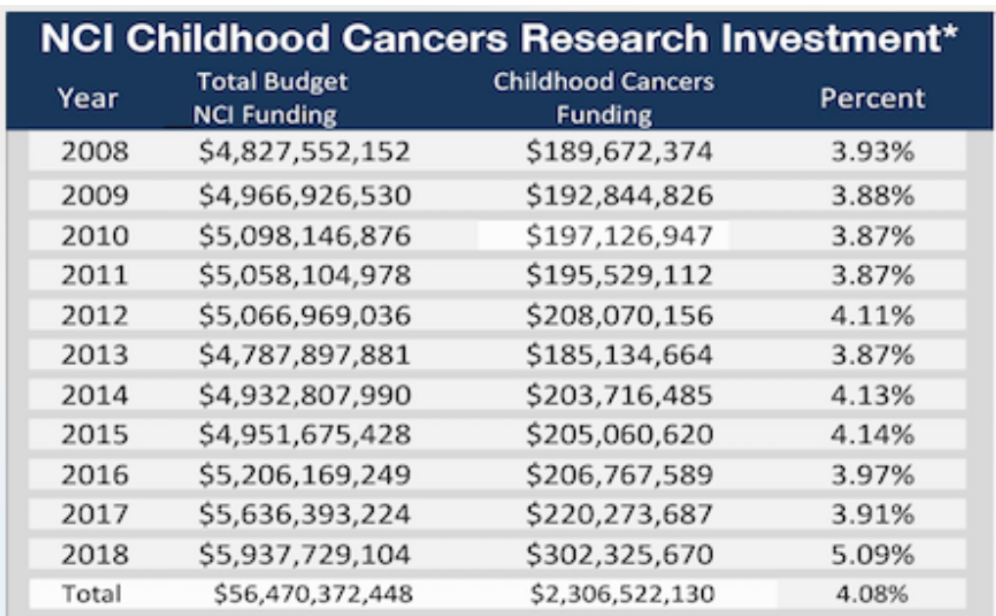
About the NCI Funded Inquiry Portfolio (https://fundedresearch.cancer.gov/nciportfolio/)
The NCI Funded Research Portfolio (NFRP) web site contains information nearly research grants, contract awards, and intramural research projects funded by the National Cancer Found. The NFRP provides admission to diverse NCI budget reports that contain information about research funding co-ordinate to specific inquiry categories. It likewise provides the power to search the database in various ways, including text searching of projection abstracts and the ability to search the NIH research categories that are assigned to projects carried out by extramural and intramural groups.(7D)
How does NCI generate NFRP funding information?
At the close of each financial twelvemonth, NCI asks each of its scientific organizations to report their research funding according to specific research categories. The reports that NCI intramural and extramural programs provide are then combined to determine the NCI funding totals for individual enquiry areas. The full research funding for each category is reviewed and verified before NCI publishes on the NCI web site, Cancer.gov.(7D)
What is scientific coding?
Scientific coding refers to the categorization of research projects according to scientific focus. In this process, research projects are analyzed and classified according to scientific topic and content. Scientific coding allows the development of science-based budget information, which can be used in portfolio analysis to examine the distribution of funds across research areas. Scientific coding is also necessary to answer inquiries nigh the scientific and budgetary aspects of Constitute-funded research. NCI employs a sophisticated system of scientific coding in which trained professionals and/or scientific staff analyze grant applications, contracts, and intramural projects to classify each projection for its degree of relevance to Special Interest Category (SIC) and Organ Site (SITE) codes. This coding structure is meant to depict in a consequent style the major scientific disciplines requested past NIH, DHHS, Congress, and the public. A critical characteristic of coded data is comparability from one fiscal year to the next. This process allows the Constitute to respond apace to requests for information from NCI staff and the broader customs. The coding definitions used by the NCI intramural plan are consistent with those used for extramural grants and enquiry and development (R&D) contracts to maintain accuracy across the Found'southward portfolio.(7D)
Another study, preferred by OAR, is the NIH RePORTER, which is a congressionally-mandated system all NIH Institutes and Centers (ICs) utilize to report data by fiscal year (FY). This tool highlights annual back up for various enquiry, status, and disease categories (RCDC) based on grants, contracts, and other funding mechanismsused across NIH.
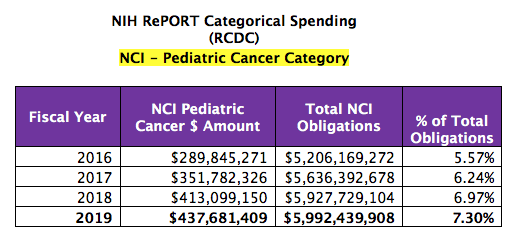
According to OAR, like the NFRP, the NIH RePORTER as well does non account for the totality of NCI'due south investment in a given expanse of research because basic science awards cannot exist categorized by private cancer type. Using Total NCI Obligations, without making allowances for NIH items included in the Pediatric Cancer Corporeality, would misconstrue the percentage of Total Obligations.
While both of the above reports, The NFRP and the NIH RePORTER, seem unable to capture a completely accurate measure out of childhood cancer research expenditure equally it relates to total research dollars, maybe a better method to measure out progress may be to compare NIH RePORTER pediatric dollars (c) to the Total NIH Dollars (d) for each fiscal year. This method would show changes from one year to the side by side. Note that the chart below shows that the pediatric cancer expenditures are growing from 2016 to 2019.
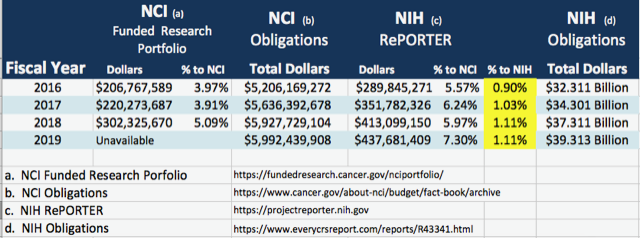
Survival
Pediatric Cancer five-Year Observed Survival Rates, Ages Nascence to 19 Years (one) The tabular array below is a representation of the estimated five-twelvemonth survival rates for various types of childhood cancers for years 2009 through 2015. It should be noted the survival rates listed beneath reflect general rates and in no fashion are a representation of an anticipated actual survival outcome for whatever individual child . (1A)
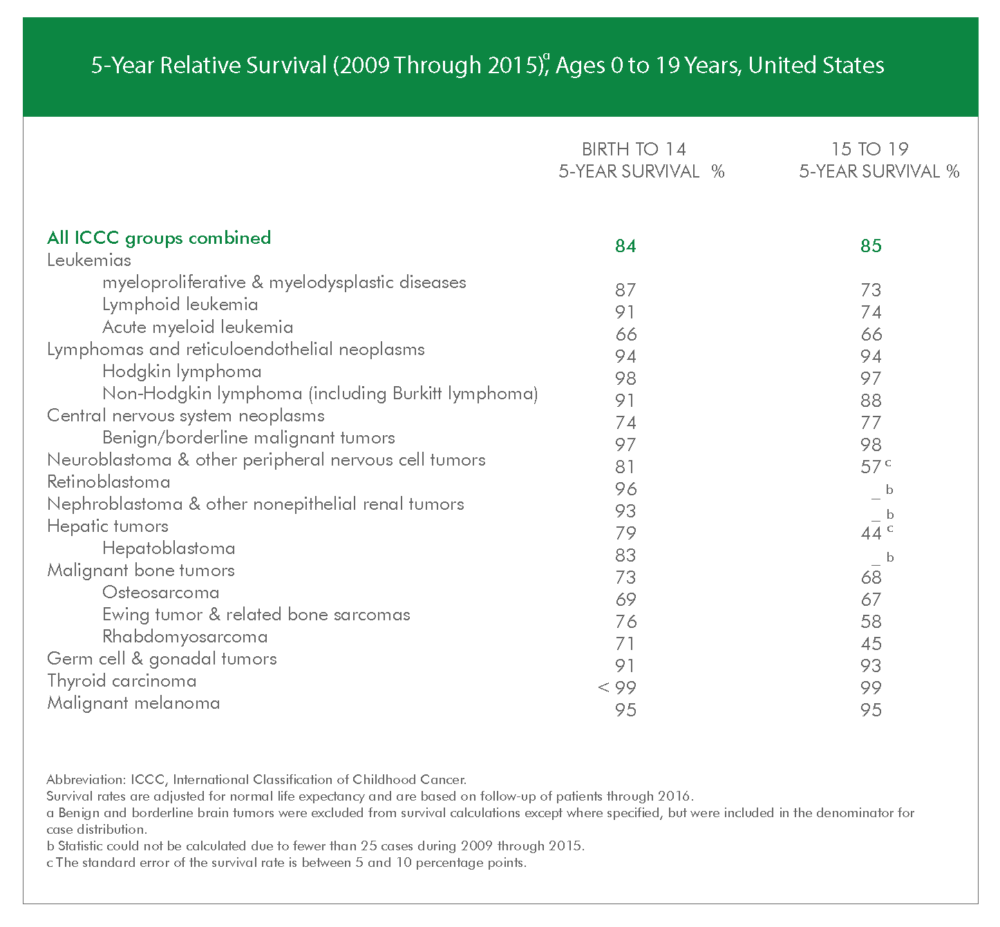
- The boilerplate 5-yr survival rate for childhood cancers when considered as a whole is 84%. (1A, 3)
- Cancer survival rates vary not merely depending upon the type of cancer, but also upon private factors attributable to each child. (6)
- The average 5-twelvemonth survival rate, non including children with ALL, is lxxx%. (1)
- 5 twelvemonth survival rates can range from almost 0% for cancers such as DIPG (2.ii% 48 ) , a type of brain cancer, to as high every bit 90% for the most common type of babyhood cancer known every bit Acute Lymphoma Leukemia (ALL). (ane)
- Diffuse intrinsic pontine glioma (DIPG) represents approximately 80% of the malignant brainstem tumors occurring in children. (34)
- Despite numerous clinical trials, the issue of children with DIPG continues to remain dismal, with a median survival of only 11 months, while just x% of DIPG patients accept ≥ two-year overall survival (Bone) rate. (48)
- 12.2% of all newly diagnosed brain tumors occur nether age 20. (7G)
- In 2015 there were virtually 429,000 childhood cancer survivors in the United States. This number is projected to grow to more than 500,000 by 2020. (27)
- Approximately 1 in 530 immature adults between the ages of 20 and 39 is a survivor of childhood cancer. (1)
Mortality
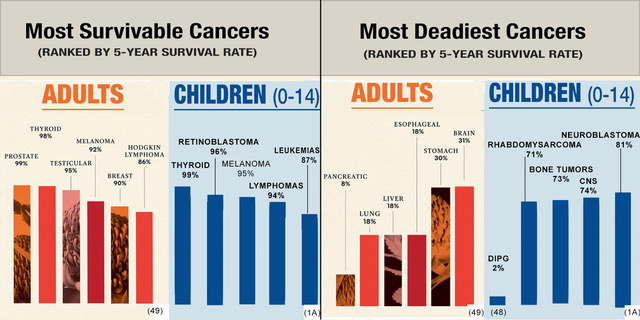
- Cancer is the number one cause of expiry past illness among children. (4) Cancer alone represents well-nigh half of the top seven causes of expiry by disease in children anile 0-nineteen yrs. (35)
- 1/3 of childhood brain and CNS cancers occur among those aged v-nine, median age at decease is age 9. (7i)
- On boilerplate, most sixteen% of children die within 5 years of diagnosis. Among those children who survive to v years from diagnosis, 18% of them will die over the side by side 25 years. (8)
- Overall cancer death rates among children ages 0 to fourteen years decreased an boilerplate of one.iv% per year. Amidst adolescents and young adults ages 15 to 39 years, overall cancer death rates decreased an average of 1.0% per year. (37)
- Those that survive the 5 years have an viii times greater mortality charge per unit due to the increased risk of liver and eye disease and increased risk for reoccurrence of the original cancer or of a secondary cancer . (8)
- There are 70 potential life years lost on average when a child dies of cancer compared to 15 potential life years lost for adults. (7B)
- Brain cancer represents 29.9% of total babyhood cancer deaths while leukemia accounts for 24.9% ( 7E)
- Worldwide, 100,000 children lose their lives every twelvemonth to cancer. (33A)
FDA Approved Drugs for Childhood Cancers
Highlighted drugs beneath were approved in the beginning example for use in cancer treatment for children
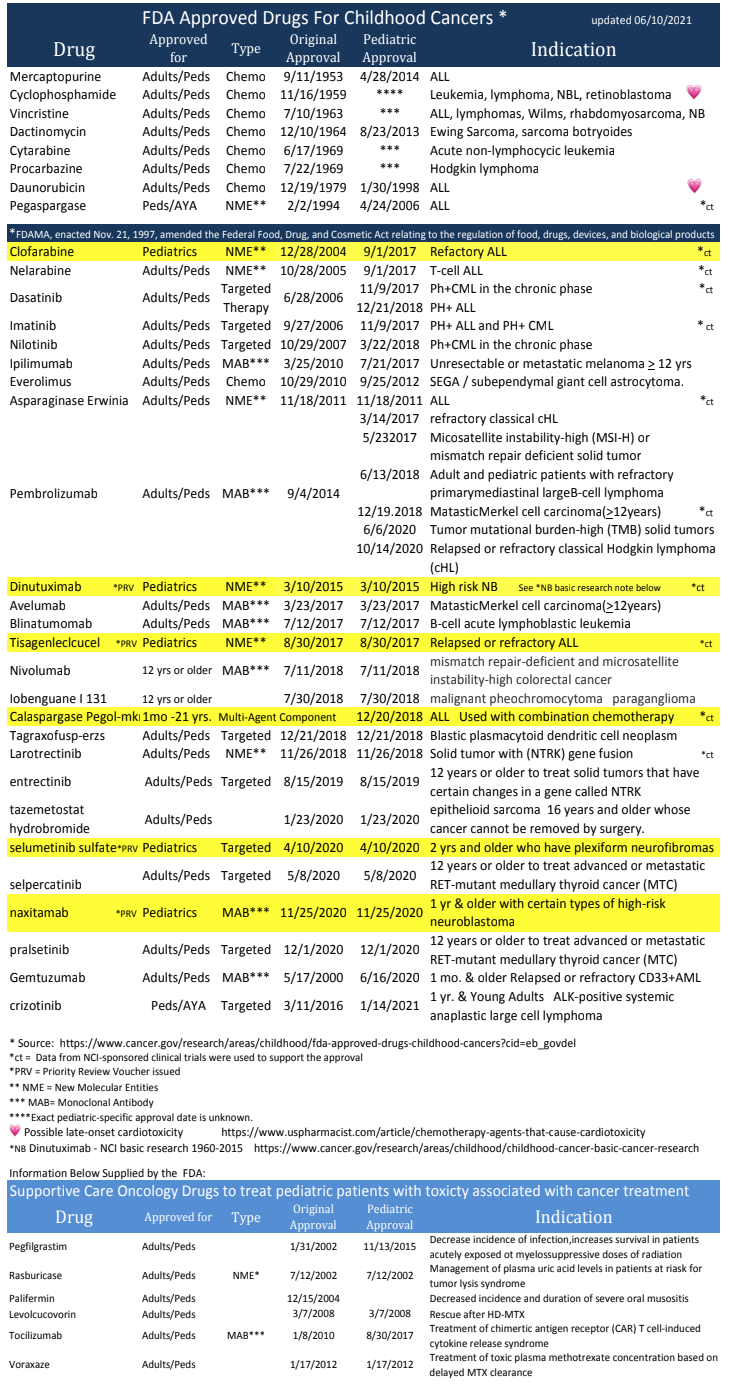
Drug Evolution
- Between the years of 2009 and 2019, nine of the 11 drugs used to treat acute lymphoblastic leukemia — which is the most common childhood cancer — were in and out of shortage. (32)
- While hundreds of cancer drugs have been developed and approved for adults, the FDA, through 2020 has approved a total of 34 drugs for use in the handling of babyhood cancers. 28 of the drugs were originally approved only for adult employ. Today nosotros have simply half dozen drugs that were approved in the first instance for use in cancer treatment for children: Teniposide (1992 for ALL) use at present discontinued past NCI, clofarabine (2004 for ALL), dinutuximab (2015 for NB), tisagenlecleucel (2017 for ALL), calaspargase pegol-mk (2018 for ALL), selumetinib (2020 for NF1) and naxitamab (2020 for NB). (7)
- The FDA awarded Priority Review Vouchers (PRV) for four of the half dozen drugs originally approved in the first instance for cancer treatment for children. PRV's are transferable and are desired incentives for developers of drugs for rare pediatric diseases. Holders of a PRV become a faster FDA drug approval process for a future drug of their choice. The vouchers are transferable and may be sold or traded. (42)
Global Facts
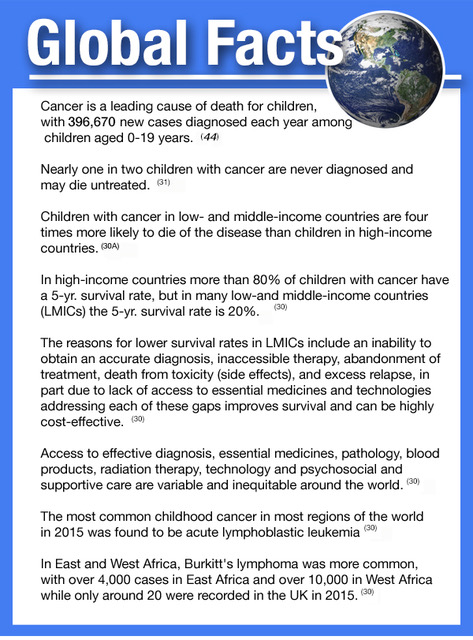
- In 2018, The World Wellness Organization (WHO) launched the Global Initiative for Childhood Cancer with partners to provide leadership and technical assistance to support governments in building and sustaining high-quality babyhood cancer programs. The goal is to reach at least 60% survival rate globally past 2030, for all children with cancer. This represents an judge doubling of the electric current cure rate and will salve an additional 1 million lives over the adjacent decade. The objectives are to increment capacity of countries to deliver best practices in childhood cancer care and too to prioritize babyhood cancer and increase available funding at the national and global levels. (30)
- It is estimated that there will be 13.7 million cases of childhood cancer between 2020-2050. Unless there are major improvements in diagnosis and treatments, of this, 45% will go undiagnosed and 11.1 million volition die if no further investments in interventions are made. The vast bulk, almost 85%, will be full-bodied in developing countries. (33A)
- Global 5-year net childhood cancer survival is currently estimated at 37.4%. (46)
Psychosocial Intendance (20)
- Childhood cancer threatens every aspect of the family's life and the possibility of a futurity, which is why optimal cancer treatment must include psychosocial care. xi
- The provision of psychosocial care has been shown to yield meliorate management of mutual disease-related symptoms and adverse effects of treatment such equally hurting and fatigue. 12
- Depression and other psychosocial concerns can affect adherence to treatment regimens by impairing cognition, weakening motivation, and decreasing coping abilities. thirteen
- For children and families, treating the hurting, symptoms, and stress of cancer enhances quality of life and is equally important as treating the illness. 14
- Childhood cancer survivors reported higher rates of hurting, fatigue, and sleep difficulties compared with siblings and peers, all of which are associated with poorer quality of life. 15
- Changes in routines disrupt day-to-24-hour interval performance of siblings . 16 Siblings of children with cancer are at adventure for emotional and behavioral difficulties, such as anxiety, low, and postal service traumatic stress disorder. 17
- Symptoms of posttraumatic stress disorder are well documented for parents whose children have completed cancer treatment. 18
- Chronic grief has been associated with many psychological (e.g., depression and feet) and somatic symptoms (e.thou., loss of appetite, sleep disturbances, fatigue), including increased mortality risk. 19
- Cancer survivors in the United States reported medication apply for anxiety and depression at rates nearly ii times those reported by the general public, likely a reflection of greater emotional and physical burdens from cancer or its handling. 21
- Financial hardship during babyhood cancer has been found to affect a significant proportion of the population and to negatively bear on family wellbeing. 22
- Adolescents with cancer experienced significantly more Wellness Related Hindrance (HRH) of personal goals than healthy peers, and their HRH was significantly associated with poorer health-related quality of life, negative affect, and depressive symptoms. 23
- Peer relationships of siblings of children with cancer are similar to classmates, though they experience small reductions in activity participation and school functioning. 24
- Chronic wellness conditions resulting from babyhood cancer therapies contribute to emotional distress in developed survivors. 25
- Parents have been found to report pregnant worsening of all their ain health behaviors, including poorer diet and nutrition, decreased concrete action, and less time spent engaged in enjoyable activities six to 18 months following their child's diagnosis. 26
Factors Affecting Follow Up Care (43)
Stakeholders GAO interviewed and studies GAO reviewed identified three factors that affect admission to follow-up care for childhood cancer survivors—individuals of any age who were diagnosed with cancer from ages 0 through 19. These factors are care affordability, survivors' and health intendance providers' knowledge of appropriate care, and proximity to care. Babyhood cancer survivors need admission to follow-upwards care over time for serious wellness effects known as late effects—such equally developmental problems, heart conditions, and subsequent cancers—which result from their original cancer and its treatment.
Affordability: Survivors of childhood cancer may have difficulty paying for follow-upwardly intendance, which can impact their access to this care. For case, one written report found that survivors were significantly more likely to have difficulty paying medical bills and filibuster medical care due to affordability concerns when compared to individuals with no history of cancer.
Knowledge: Survivors' admission to appropriate follow-up care for tardily effects of childhood cancer can depend on both survivors' and providers' knowledge about such care, which tin can touch admission in diverse ways, according to stakeholders GAO interviewed and studies GAO reviewed:
- Some survivors may have been treated for cancer at an early age and may have limited awareness of the need for follow- upwards care.
- Some primary or specialty care providers may non be knowledgeable well-nigh guidelines for appropriate follow-up care, which can affect whether a survivor receives recommended treatment. Follow-upward intendance may include psychosocial care (e.yard., counseling), and palliative care (e.yard., pain management).
Proximity: Survivors may have difficulty reaching appropriate care settings. Stakeholders GAO interviewed and studies GAO reviewed noted that childhood cancer survivors may have to travel long distances to receive follow-up care from multidisciplinary outpatient clinics—referred to as childhood cancer survivorship clinics. The lack of proximity may make information technology particularly difficult for survivors with limited financial resources to attach to recommended follow-upward intendance.
Endnotes
1 American Cancer Club, Childhood and Adolescent Cancer Statistics, 2014
https://www.cancer.org/content/dam/cancer-org/enquiry/cancer-facts-and-statistics/annual-cancer-facts-and-figures/2014/special-section-cancer-in-children-and-adolescents-cancer-facts-and-figures-2014.pdf
1A American Cancer Society, A Journal for Clinicians, Cancer Statistics 2020, Table 12: Example Distribution (2012 Through 2016) and v-Year Relative Survival (2009 Through 2015) a by Age and ICCC Blazon, Ages Nascence to 19 Years, United States.
https://acsjournals.onlinelibrary.wiley.com/doi/full/10.3322/caac.21590
2 St. Jude Children's Enquiry Hospital, (JAMA. 2013:309 [22]: 2371-2381)
http://jama.jamanetwork.com/article.aspx?articleid=1696100
3 National Center Biotechnology Information, Declining Childhood & Adolescent Cancer Bloodshed, Cancer 2014
http://world wide web.ncbi.nlm.nih.gov/pubmed/24853691
4 National Vital Statistics Report, vol. 62.6, Dec twenty, 2013
http://www.cancer.gov/types/childhood-cancers/child-adolescent-cancers-fact-sheet
5 National Center for Biotechnology Information, U.S. National Library of Medicine
https://www.ncbi.nlm.nih.gov/books/NBK61974/
six American Society of Clinical Oncology
http://jco.ascopubs.org/content/28/15/2625.short
6A American Society of Clinical Oncology (ASCO)
https://www.cancer.internet/cancer-types/childhood-cancer/introduction
7 National Cancer Institute, http://www.cancer.gov/research/areas/childhood/fda-approved-drugs-childhood-cancers?cid=eb_govdel
7A National Cancer Found, SEER Median Age of Diagnosis 2008-2012, Table 1.12
http://seer.cancer.gov/csr/1975_2012/results_merged/topic_med_age.pdf
7B National Cancer Institute, SEER Cancer Statistics Review 1973-1997 (NCI 2000)
http://jnci.oxfordjournals.org/content/93/5/341.full
7C National Cancer Institute, NIH/NCI
https://fundedresearch.cancer.gov/nciportfolio/
7D National Cancer Constitute, NIH/NCI
https://fundedresearch.cancer.gov/nciportfolio/about.jsp
7E Centers for Disease Control and Prevention,
https://world wide web.cdc.gov/nchs/products/databriefs/db257.htm
7F National Cancer Plant, SEER Cancer Statistics. Almanac Study to the Nation 2018
7G National Cancer Institute, Percentage of New Cases past Age Group: Encephalon and Other Nervous Organization Cancer
SEER 21 2012-2016, All Races, Both Sexes,
7H National Cancer Establish, Pediatric Supportive Care (PDQ®)–Patient Version
https://www.cancer.gov/types/childhood-cancers/pediatric-care-pdq
(7i) National Cancer Institute, SEER Percentage of Deaths by Age, All races, Both Sexes
http://seer.cancer.gov/csr/2014_2018/results_merged/topic_med_age.pdf
eight Journal of the National Cancer Establish "Cause-Specific Tardily Mortality Among 5 Year Survivors"
http://jnci.oxfordjournals.org/content/100/19/1368.full
9 NCI, SEER Historic period-Specific Rates and Counts for Cancer Sites by Single Year of Age at Diagnosis, Tabular array 28.xiii
http://seer.cancer.gov/csr/1975_2012/results_single/sect_28_table.13_2pgs.pdf
10 Boosted information in this statement was obtained from several reliable and administrative sources
11 Institute of Medicine, 2008 – Cancer Care for the Whole Patient
12 Jacobsen et al., 2012 (Journal of Clinical Oncology, 30 (xi), p.1151-1153)
thirteen Found of Medicine, 2008
14 Institute of Medicine 2015 – Comprehensive Care for Children with Cancer and Their Families
xv Children'due south Oncology Grouping Long Term Follow-Up Guidelines, 2013
xvi Alderfer et al., 2010 (Psycho-oncology, 19 (eight), p. 789-805)
17 Alderfer et al., 2003 (Periodical of Pediatric Psychology, 28 (4), p. 281-286)
18 Kazak et al., 2004 (Periodical of Pediatric Psychology, 29 (3), p. 211-219)
19 Alam et al., 2012 (Death Studies, 36 (one), p. 1-22)
twenty Psychosocial care addresses the effects that cancer treatment has on the mental wellness and emotional wellbeing of patients, their family unit members, and their professional person caregivers. Psychosocial care is not provided by a single profession solitary: Instead, every patient-healthcare provider interaction provides an opportunity to assess the stressors and concerns of children and their family members.
21 Hawkins et al., 2017 (Periodical of Clinical Oncology, 5 (1), 78-87)
22 Bona et al., 2014 (Periodical of Pain Symptom Management, 47 (3), 594-600)
23 Schwartz & Brumley, 2017 (Journal of Adolescent & Young Adult Oncology, six (1), 142-149)
24 Alderfer et al., 2015 (Periodical of Pediatric Psychology, xl (three) 309–319)
25 Vuotto et al., 2017 (Cancer, 123 (iii), 521-528)
26 Wiener et al., 2016 (Journal of Pediatric Oncology Nursing, 33(5), 378–386)
27 Robison LL, Hudson MM. Survivors of childhood & adolescent cancer: life long risks & responsibilities. Nat Rev Cancer 22014; 14:61-70 NCI
https://world wide web.cancer.gov/types/childhood-cancers/child-boyish-cancers-fact-canvas
28 UChicagoMedicine Agreement risks for childhood cancer survivors
https://www.uchicagomedicine.org/forefront/cancer-manufactures/understanding-risks-for-childhood-cancer-survivors
29 Kebudi, R. and F.B. Cakir, Management of Diffuse Pontine Gliomas in Children: Contempo Developments. Pediatric Drugs, 2013. 15(5): 351-362
30 World Wellness System
https://world wide web.who.int/news-room/fact-sheets/particular/cancer-in-children
30A Earth Wellness Organization
https://www.who.int/cancer/babyhood-cancer/en/
31 The Lancet. ScienceDaily. ScienceDaily, 26 February 2019.
https://www.sciencedaily.com/releases/2019/02/190226184140.htm
32 FDA Study Drug shortages
https://www.fda.gov/drugs/drug-shortages/report-drug-shortages-root-causes-and-potential-solutions
33 Lancet Oncology. 2015 Mar; 16(iii): e123–e136. doi: 10.1016/S1470- 2045(14)70409-seven
https://www.ncbi.nlm.nih.gov/pmc/articles/PMC4485458/
33A Lancet Oncology Sustainable care for children with cancer 03/30/2020
https://www.thelancet.com/commissions/childhood-cancer
34 Effect of Fourth dimension from Diagnosis to Outset of Radiotherapy on Children with Diffuse Intrinsic Pontine Glioma
2014 Jan 30. doi: x.1002/pbc.24971 PMCID: PMC4378861NIHMSID: NIHMS667729 PMID: 24482196
https://www.ncbi.nlm.nih.gov/pmc/articles/PMC4378861/
35 Centers for Disease Control and Prevention, National Centre for Health Statistics. Underlying Cause of Death 1999-2019 on CDC WONDER Online Database, released in 2020. Data are from the Multiple Cause of Death Files, 1999-2019, equally compiled from data provided by the 57 vital statistics jurisdictions through the Vital Statistics Cooperative Program.
http://wonder.cdc.gov/ucd-icd10.html
36 The National Children'southward Cancer Society, The Economical Affect of Babyhood Cancer, November thirty, 2018
https://www.thenccs.org/wp-content/uploads/2017/04/the-economic-bear upon-of-childhood-cancer.pdf
37 National Institutes of Wellness Annual Report 2020
https://world wide web.nih.gov/news-events/news-releases/annual-study-nation-cancer-death-rates-continue-pass up-2020
38 American Cancer Society, Treatment and Survivorship Statistics, 2019
https://acsjournals.onlinelibrary.wiley.com/doi/10.3322/caac.21565
39 National Cancer Constitute, NIH/NCI
https://www.cancer.gov/types/babyhood-cancers/late-furnishings-pdq#_417
forty American Cancer Society Cancer Facts & Figures 2020
https://world wide web.cancer.org/research/cancer-facts-statistics/all-cancer-facts-figures/cancer-facts-figures-2020.html
41 U.South. News & Earth Reports "Childhood Cancer Survivors Still Face Shorter Life Expectancy," January two, 2020
https://world wide web.usnews.com/news/healthiest-communities/articles/2020-01-02/life-expectancy-for-childhood-cancer-survivors-has-improved-report-says
42 Food and Drug Assistants, FDA, 12,27,2020, Rare Pediatric Affliction (RPD) Designation and Voucher Programs
https://www.fda.gov/industry/developing-products-rare-diseases-conditions/rare-pediatric-illness-rpd-designation-and-voucher-programs
43 The states Regime Accounting Offices, GAO-twenty-636R, Jul 31, 2020. "Survivors of Childhood Cancer: Factors Affecting Access to Follow-upwards Care"
https://www.gao.gov/products/gao-20-636r
44 Cancer Epidemiology, "Babyhood cancer: Estimating regional and global incidence," Volume 71, Part B, April 2021, 101662, Used 3.4 2015 Global Childhood Cancer (GCC) Model
https://www.sciencedirect.com/science/commodity/pii/S1877782119301729
45 NIH/National Cancer Institute, Historic period-Adjusted and Age-Specific SEER Cancer Incidence Rates, 2014-2018, Tabular array ii.1
https://seer.cancer.gov/csr/1975_2018/results_single/sect_02_table.01_2pgs.pdf
46 Lancet Oncology, Volume 20, Issue vii, July 2019, Pages 972-983, "Global childhood cancer survival estimates and priority- setting: a simulation-based assay,"
https://www.sciencedirect.com/science/article/abs/pii/S1470204519302736
47 Cancer Epidemiology Biomarkers June 7 2021, DOI:x.1158/1055-9965.EPI-21-0154
https://cebp.aacrjournals.org/search/%252B20%252Byears%252Bpost%252Bdiagnosis%20exclude_meeting_ abstracts%3A1
48 Hofmann et al. (J Clin Oncol, 2018 vol. 36(nineteen) pp. 1963-1972)
https://pubmed.ncbi.nlm.nih.gov/29746225/
49 National Cancer Institute Illustration by Cristiana Couciero May 16, 2016
THIS Certificate IS Not INTENDED TO Offering SPECIFIC STATISTICS REGARDING AN INDIVIDUAL PATIENT OR THE PATIENT'S SPECIFIC FORM OF CANCER AND IS Non A SUBSTITUTE FOR Data THAT MAY Be SOUGHT FROM A Physician. IT IS MERELY INTENDED, BASED ON Data Soon Bachelor TO THE AUTHORS, TO Be A Expert Organized religion GENERAL PRESENTATION OF CHILDHOOD CANCER STATISTICS THAT MAY Exist HELPFUL TO OTHERS SEEKING SUCH GENERAL INFORMATION.
September 1, 2021
Source: https://cac2.org/interest-groups/awareness/childhood-cancer-fact-library/
Posted by: cooperexan1959.blogspot.com

0 Response to "What Amount Of Money Is Given To Children's Cancer"
Post a Comment